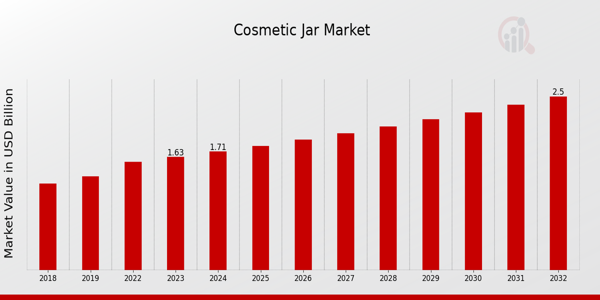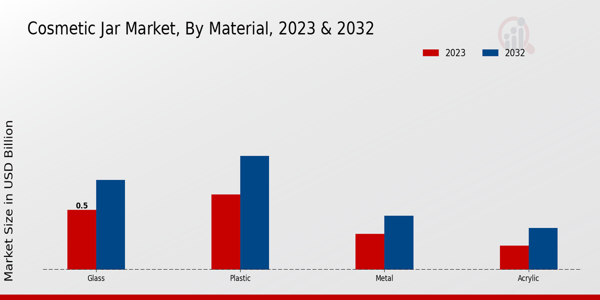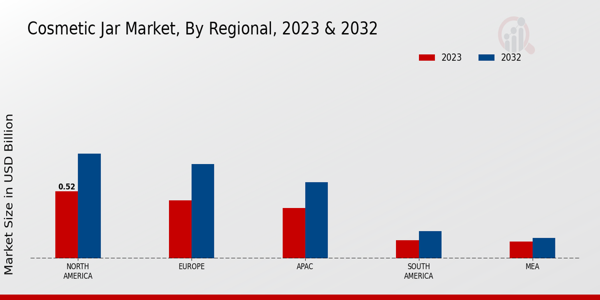Global Cosmetic Jar Market Overview
The Cosmetic Jar Market Size was estimated at 1.80 (USD Billion) in 2024. The Cosmetic Jar Industry is expected to grow from 1.89(USD Billion) in 2025 to 2.89 (USD Billion) by 2034. The Cosmetic Jar Market CAGR (growth rate) is expected to be around 4.9% during the forecast period (2025 - 2034).
Key Cosmetic Jar Market Trends Highlighted
The factors that are fuelling the Growth and expansion of the Cosmetic Jar Market include the growing demand for skincare and beauty products which points towards the need for packaging. Consumers are not just focused on the functionality of the product but also on its aesthetic and eco-friendly packaging. This change is causing brands to rethink their offerings which is in turn making the cosmetic jars more versatile and diverse. Additionally, the trend of influencer marketing in social media increases this demand, as consumers want items endorsed by their favorite celebrities. There is a wealth of possibilities in the market, particularly with regard to green packaging alternatives.
With the increase in awareness of environmental concerns, customers have begun to prioritize brands that utilize eco-friendly products and materials. Such companies which focus on developing biodegradable, or recyclable materials will be able to profit from this burgeoning segment. In addition, the customization of jars in terms of sizing and design can give the brands the competitive edge. In recent times, trends such as cosmetic jars with minimalistic designs and refillable containers have become more popular. It appears that consumers are using a more functional design that discards excess materials in bulk. There is also a trend of clean beauty products which encourages companies to make their product ingredients list available to consumers without compromising on the packaging which is tailored for health-focused customers.
The current trend of consumers buying into wellness and self-care is expected to be a mainstay, hence sustaining demand for the cosmetic jars market. Following these trends will not only serve the preferences of consumers but will also deepen brand trust and enshrine the company’s position in the market.
Cosmetic Jar Market

Source: Primary Research, Secondary Research, MRFR Database and Analyst Review
Cosmetic Jar Market Drivers
Rising Demand for Sustainable Packaging Solutions
The Cosmetic Jar Market Industry is witnessing a significant shift towards sustainable and eco-friendly packaging solutions. As consumers become more environmentally conscious, the demand for products that utilize recyclable or biodegradable materials is skyrocketing. This trend is compelling manufacturers to innovate their packaging methods and use materials that minimize environmental impact. The shift towards sustainability not only aligns with consumer values but also enhances brand loyalty and appeal among eco-conscious customers.By investing in sustainable packaging, brands can differentiate themselves in a crowded marketplace. Additionally, regulatory pressures regarding waste management and sustainability are influencing companies to adapt. Investors and stakeholders in the Cosmetic Jar Market Industry are increasingly supporting brands that prioritize sustainability, fostering an environment where eco-friendly jars contribute to overall market growth and attractiveness.The expansion into markets with stringent sustainability regulations further stimulates the demand, as companies seek compliance while remaining competitive. The emphasis on sustainability is not a fleeting trend but a substantial shift that is expected to shape the future landscape of the Cosmetic Jar Market Industry for years to come.
Growth of the Personal Care and Cosmetics Industry
The Cosmetic Jar Market Industry is closely aligned with the booming personal care and cosmetics sector. The rise in disposable income and the increasing focus on personal grooming and aesthetics have led to an overall increase in product consumption. As beauty standards evolve, consumers are willing to invest more in premium and luxury cosmetics, which often require high-quality packaging. This expansion in the cosmetics category fuels demand for cosmetic jars, specifically designed to cater to a variety of products such as creams, serums, and other skincare essentials.This growth is not only seen in traditional markets but also expanding across emerging economies where cosmetic usage is rapidly increasing. Therefore, the growth of this sector directly boosts the Cosmetic Jar Market Industry.
Technological Advancements in Packaging Innovations
Advancements in packaging technology are acting as a significant driver in the Cosmetic Jar Market Industry. Innovations such as airless pumps, air-tight closures, and anti-bacterial materials are enhancing the functionality and convenience of cosmetic jars. These advancements not only improve the user experience but also extend the shelf-life of cosmetic products, which is becoming increasingly important for both manufacturers and consumers alike.As brands recognize the potential for differentiation through innovative packaging, they are investing significantly in R&D. The integration of smart technologies to monitor and inform users about product freshness is also gaining traction. The focus on enhancing packaging performance is shaping marketing strategies and allowing brands to establish a competitive edge in the Cosmetic Jar Market Industry.
Cosmetic Jar Market Segment Insights
Cosmetic Jar Market Material Insights
The Cosmetic Jar Market revenue is expected to reach 1.63 USD Billion in 2023, reflecting a noteworthy interest in various materials used for cosmetic jars. The market exhibits a rich segmentation, particularly within the Material segment, comprising Glass, Plastic, Metal, and Acrylic. In 2023, the Glass segment holds a market value at 0.5 USD Billion, emphasizing its significance due to its aesthetic appeal and recycling capabilities, which resonate well with environmentally conscious consumers. Plastic comes next, valued at 0.63 USD Billion, and is recognized for its versatility and lightweight nature, making it a popular choice for both manufacturers and consumers. The Metal segment, valued at 0.3 USD Billion, serves as a robust option for premium products, while also contributing to a sophisticated and modern aesthetic in the cosmetic industry. In contrast, the Acrylic segment, although valued at 0.2 USD Billion, showcases its lightweight and durable characteristics, appealing to niche markets seeking unique design possibilities. As the market landscape evolves, these material choices not only cater to diverse consumer preferences but also address sustainability trends where recyclability and eco-friendliness are paramount. Notably, Glass and Plastic dominate the market with majority holdings, driven by their extensive applications and consumer demand across various cosmetic products. Market growth in recent years has been fueled by a rising trend of natural and organic cosmetic products packaged in eco-friendly materials, prompting manufacturers to innovate with their offerings. Challenges remain regarding the environmental impact of non-recyclable materials and the ongoing need for improved production standards. Opportunities are being recognized in the expansion of biodegradable options and alternative materials that still meet the aesthetic and functional demands of the Cosmetic Jar Market industry. The growth trajectory observed leading to 2032, where the market is forecasted to reach 2.5 USD Billion, presents a prime opportunity for manufacturers to evaluate their material strategies and capitalize on emerging consumer preferences. Thus, the segmentation within the Cosmetic Jar Market statistics reveals not only the competitive landscape but also the necessary alignment with evolving market drivers.

Source: Primary Research, Secondary Research, MRFR Database and Analyst Review
Cosmetic Jar Market Capacity Insights
The Cosmetic Jar Market is poised for growth, with a market value expected to reach 1.63 billion USD in 2023. The capacity segment plays a vital role in shaping consumer preferences and product offerings. Within this segment, various jar sizes cater to diverse consumer needs and trends. Smaller jars, particularly those under 50ml, are gaining traction due to their convenience and portability, appealing to consumers who prefer travel-friendly options. Meanwhile, jars in the 50ml to 100ml range are popular as they strike a balance between usability and value, making them suitable for both skincare and makeup applications.The 100ml to 200ml capacity segment is significant, often favored by manufacturers for bulk purchases, and is commonly used for premium products. Larger jars, exceeding 200ml, also dominate in the market, particularly in wholesale beauty products and salon offerings, as they provide cost-effective benefits for both consumers and businesses. As sustainability trends gain importance, the packaging choices within these capacities become crucial, highlighting the Cosmetic Jar Market statistics, segmentation, and data reflecting changing demands that drive market growth.
Cosmetic Jar Market Closure Type Insights
The Cosmetic Jar Market, focusing on the Closure Type segment, showcases a diverse range of options that cater to various consumer preferences and product requirements. The overall market is valued at 1.63 billion USD in 2023 and is projected to grow steadily. Among the closure types, the Screw Cap design remains a favored choice due to its durability and ease of use, making it suitable for products that require a secure seal. Flip Top closures also gain traction, particularly for products requiring quick access, appealing to the convenience-focused consumer.The Pump Dispenser is significant for its hygiene benefits and portion control, making it ideal for liquid or cream-based cosmetics. Meanwhile, Spray Tops dominate in products aimed at even distribution, often seen with facial mists and perfumes. This variety within the closure types contributes to the overall growth and adaptability of the Cosmetic Jar Market, reflecting changing consumer habits and preferences, as well as driving innovation in design and functionality. The market growth is supported by an increasing demand for eco-friendly and sustainable packaging solutions, pushing manufacturers to adapt their closure types accordingly, which highlights opportunities in the market.
Cosmetic Jar Market End Use Insights
The Cosmetic Jar Market, projected to be valued at 1.63 billion USD in 2023, showcases a diverse array of end-use applications. The skincare segment holds a significant share, driven by the increasing consumer focus on skincare routines and the demand for premium products that require quality packaging. Makeup also plays a crucial role in this market, as a growing preference for cosmetic jars over traditional packaging solutions complements the creative branding strategies of cosmetic companies. Moreover, the haircare sector is expanding as more consumers invest in hair treatments and products that require efficient storage solutions, highlighting the necessity of jars.Fragrance, although often seen as a niche, continues to contribute substantially, particularly with upscale brands favoring aesthetically appealing presentations. These dynamics reflect broader market trends toward personalization, sustainability, and convenience, influencing the overall Cosmetic Jar Market revenue. As the market progresses towards 2032, a robust growth trajectory is evident, underlining the importance of these segments within the overall Cosmetic Jar Market industry, demonstrating diverse opportunities amid challenges such as competition and changing consumer preferences.
Cosmetic Jar Market Regional Insights
In 2023, the Cosmetic Jar Market revenue is valued at 1.63 USD Billion, with various regions contributing to this valuation through distinct dynamics. North America holds a significant share with a valuation of 0.52 USD Billion, anticipated to grow to 0.81 USD Billion by 2032, reflecting its major influence in the market due to consumer demand for premium cosmetic products. Europe closely follows, valued at 0.45 USD Billion in 2023 and expected to reach 0.73 USD Billion in 2032, driven by a strong focus on sustainable and eco-friendly packaging.The APAC region, accounting for 0.39 USD Billion in 2023, represents a growing market as beauty trends shift and consumer spending increases, with a valuation projected to rise to 0.59 USD Billion by 2032. In contrast, South America and MEA are relatively smaller but emerging markets, valued at 0.14 USD Billion and 0.13 USD Billion in 2023, respectively. South America is expected to reach 0.21 USD Billion while MEA anticipates a growth to 0.16 USD Billion by 2032, indicating potential opportunities driven by urbanization and increasing disposable incomes.Overall, the Cosmetic Jar Market segmentation reveals varied regional influences that effectively display the adaptation trends in consumer behavior regarding cosmetic packaging.

Source: Primary Research, Secondary Research, MRFR Database and Analyst Review
Cosmetic Jar Market Key Players and Competitive Insights
The Cosmetic Jar Market is characterized by a highly competitive landscape where numerous players strive to capture market share and meet evolving consumer needs. This market encompasses a variety of product offerings, ranging from premium jars for skincare formulations to more affordable options for broader segments. Competitive insights reveal innovations in designs, environmentally friendly packaging solutions, and the introduction of smart packaging technologies that enhance user experience. Regulatory factors and increasing consumer awareness regarding sustainability and product ingredients have also begun to influence market dynamics, leading to shifts in competitive strategies among key players. The landscape is further complicated by trends such as the rising popularity of clean beauty products which emphasize transparency and natural ingredients.L'Oréal has established a formidable presence in the Cosmetic Jar Market, with its extensive range of skincare products packaged in innovative jars tailored to different consumer segments. The company's strengths lie not only in its robust brand portfolio but also in its continuous investment in research and development to create advanced formulations that resonate with modern consumers. L'Oréal leverages its global distribution network effectively, providing a wide reach for various demographics while maintaining high standards of product quality. Furthermore, the brand's commitment to sustainability initiatives, including a reduction in plastic usage and a focus on recyclable packaging, positions L'Oréal favorably as consumers increasingly seek environmentally responsible products. This strategic alignment with consumer values enhances its competitive advantage within the cosmetic jar segment.Innisfree, known for its natural and eco-friendly approach, holds a unique position in the Cosmetic Jar Market. The brand emphasizes the use of ingredients sourced from the pristine Jeju Island, allowing it to cater to a health-conscious consumer base. Innisfree's jars are often designed with minimalistic aesthetics and functionality, which appeals to a demographic that values both sustainability and style. The company's strategy includes a strong commitment to environmental initiatives, including recycling programs and the use of biodegradable materials, which resonates with today's eco-conscious consumers. Innisfree's ability to effectively market its product benefits, along with captivating storytelling about its natural ingredients, enhances its visibility and competitiveness in the market, making it a preferred choice for those seeking high-quality, environmentally friendly cosmetic jars.
Key Companies in the Cosmetic Jar Market Include
- L'Oréal
- Innisfree
- Unilever
- Amway
- Henkel
- Estée Lauder Companies
- Coty
- Mary Kay
- Oriflame
- Shiseido Company
- Beiersdorf
- Avon Products
- Revlon
- Kao Corporation
- Procter and Gamble
Cosmetic Jar Market Industry Developments
The Cosmetic Jar Market has seen notable recent developments, including alignment with sustainability practices among prominent companies such as Unilever and Estée Lauder Companies, which are reformulating packaging strategies to minimize environmental impact. L'Oréal is intensifying its focus on innovation, launching new product lines in eco-friendly jars to meet growing consumer demand for sustainable beauty options. Conversely, Kao Corporation has expanded its production capacity to cater to the rising demand for personal care products. Additionally, mergers and acquisitions are impacting the landscape, with Coty exploring strategic partnerships to enhance its market share. Innisfree has recently solidified its presence in key markets by collaborating with local distributors, emphasizing the need for accessibility. Companies like Henkel and Procter and Gamble continue to see growth in market valuation as they emphasize digital marketing and e-commerce strategies, contributing to overall market expansion. The competitive dynamics are further impacted as Beiersdorf and Avon Products adapt to trends in personalization and customization within cosmetic offerings, reflecting ongoing shifts in consumer preferences. These developments highlight an evolving environment where sustainability and innovation drive the Cosmetic Jar Market.
Cosmetic Jar Market Segmentation Insights
- Cosmetic Jar Market Material Outlook
- Glass
- Plastic
- Metal
- Acrylic
- Cosmetic Jar Market Capacity Outlook
- Less than 50ml
- 50ml to 100ml
- 100ml to 200ml
- More than 200ml
- Cosmetic Jar Market Closure Type Outlook
- Screw Cap
- Flip Top
- Pump Dispenser
- Spray Top
- Cosmetic Jar Market End Use Outlook
- Skincare
- Makeup
- Haircare
- Fragrance
- Cosmetic Jar Market Regional Outlook
- North America
- Europe
- South America
- Asia Pacific
- Middle East and Africa
| Report Attribute/Metric |
Details |
| Market Size 2024 |
1.80 (USD Billion) |
| Market Size 2025 |
1.89(USD Billion) |
| Market Size 2034 |
2.89 (USD Billion) |
| Compound Annual Growth Rate (CAGR) |
4.9% (2025 - 2034) |
| Report Coverage |
Revenue Forecast, Competitive Landscape, Growth Factors, and Trends |
| Base Year |
2024 |
| Market Forecast Period |
2025 - 2034 |
| Historical Data |
2020 - 2024 |
| Market Forecast Units |
USD Billion |
| Key Companies Profiled |
L'Oréal, Innisfree, Unilever, Amway, Henkel, Estée Lauder Companies, Coty, Mary Kay, Oriflame, Shiseido Company, Beiersdorf, Avon Products, Revlon, Kao Corporation, Procter and Gamble |
| Segments Covered |
Material, Capacity, Closure Type, End Use, Regional |
| Key Market Opportunities |
Sustainable packaging solutions, E-commerce sales growth, Customized cosmetic jars demand, Regional market expansion, Innovative design trends |
| Key Market Dynamics |
Growing demand for sustainable packaging, Increasing beauty and skincare trends, Rise in e-commerce sales, Innovations in jar design, Surge in personalized beauty products |
| Countries Covered |
North America, Europe, APAC, South America, MEA |
Frequently Asked Questions (FAQ) :
The Global Cosmetic Jar Market is expected to be valued at 2.89 USD Billion by the year 2034.
The anticipated CAGR for the Global Cosmetic Jar Market from 2025 to 2034 is 4.9%.
By 2032, North America is anticipated to hold the largest market share in the Global Cosmetic Jar Market.
The market value for plastic cosmetic jars is expected to reach 0.95 USD Billion by 2032.
Major players in the Global Cosmetic Jar Market include L'Oréal, Unilever, Estée Lauder, and Shiseido Company.
Europe is expected to grow to 0.73 USD Billion by 2032, indicating a steady market growth.
The market size for glass cosmetic jars is projected to be 0.75 USD Billion by the year 2032.
Challenges such as supply chain disruptions and regulatory changes may impact growth in the Global Cosmetic Jar Market.
The MEA segment is expected to reach a market value of 0.16 USD Billion by 2032.
The market's growth potential and increasing consumer demand for sustainable packaging present opportunities for new entrants.

















